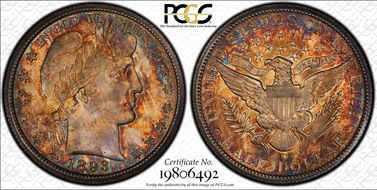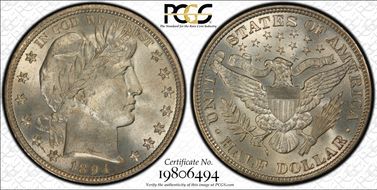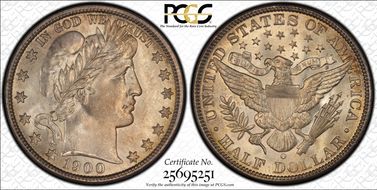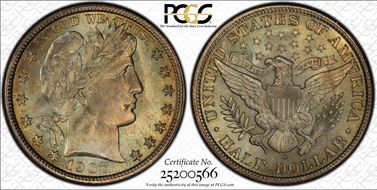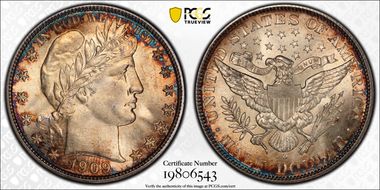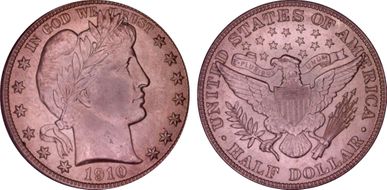PeterShireman 的钱币相册
Laibstain. The normal sized "O" mint mark. A very pretty coin with colorful natural toning that enhances smooth surfaces of this low mintage early date. Even in low grades, the 92-O is highly praised for its low population and low survival, making it an important coin in any grade. Despite the low mintage, more were saved in EF and AU and low mint state grades because of first year of issue, than otherwise would have been. In MS 64 and above, the date is very tough and at the level of MS 66 like this coin, it is among few peers. The O mint coins are from New Orleans and throughout the series of Barber Halves, there are some weak strikes. Strike weakness is usually noted on the obverse in the detail of the hair of the forehead and the stars, and on the reverse on a vertical line running through the right side of the shield and eagle's left talons. Reverse weakness is also noted in the neck feathers of the eagle and the foot and talons of the eagles' right foot. The O mint coins have the most variability in strike and finding one with a strong strike is challenging, but rewarding. Often the pricing is similar between coins graded the same numerical grade, but with different strikes. There are certain dates in the series that have notoriously weak strikes, such as some of the middle year dates, but early dates like 1893 and 1894 can also show especially weak strikes. Mintage figures for the Barber Half series in mint state are not very important, particularly in trying to predict the numbers of mint state survivors. The percentage of surviving coins in mint state only seems to have a weak association to the number minted for any given issue. The mintages do relate better to surviving coins in circulated condition as one would expect. Survival of mint state issues also relates to the time period in which these coins were produced. There were far more coin collectors in 1915 than in 1892, and the popularity of collecting coins from each mint increased in this time period due to the published work of Heaton on mint marks. The production of coin "boards" with holes for each issue also encouraged collectors to build sets with coins from all the different mints.
Laibstain. The normal sized "O" mint mark. A very pretty coin with colorful natural toning that enhances smooth surfaces of this low mintage early date. Even in low grades, the 92-O is highly praised for its low population and low survival, making it an important coin in any grade. Despite the low mintage, more were saved in EF and AU and low mint state grades because of first year of issue, than otherwise would have been. In MS 64 and above, the date is very tough and at the level of MS 66 like this coin, it is among few peers. The O mint coins are from New Orleans and throughout the series of Barber Halves, there are some weak strikes. Strike weakness is usually noted on the obverse in the detail of the hair of the forehead and the stars, and on the reverse on a vertical line running through the right side of the shield and eagle's left talons. Reverse weakness is also noted in the neck feathers of the eagle and the foot and talons of the eagles' right foot. The O mint coins have the most variability in strike and finding one with a strong strike is challenging, but rewarding. Often the pricing is similar between coins graded the same numerical grade, but with different strikes. There are certain dates in the series that have notoriously weak strikes, such as some of the middle year dates, but early dates like 1893 and 1894 can also show especially weak strikes. Mintage figures for the Barber Half series in mint state are not very important, particularly in trying to predict the numbers of mint state survivors. The percentage of surviving coins in mint state only seems to have a weak association to the number minted for any given issue. The mintages do relate better to surviving coins in circulated condition as one would expect. Survival of mint state issues also relates to the time period in which these coins were produced. There were far more coin collectors in 1915 than in 1892, and the popularity of collecting coins from each mint increased in this time period due to the published work of Heaton on mint marks. The production of coin "boards" with holes for each issue also encouraged collectors to build sets with coins from all the different mints.
Laibstain. Beautiful and colorful toning over good luster. A coin that often comes very weakly struck, but strikes run the gamut up to well struck. The Dale Friend collection had a coin that was a very strong strike, for example. Not a common coin in gem, only three are graded at MS 66, making this one tied for finest known. For comparison, the example from the Duckor collection has a softer strike, particularly in the eagle's left talon area, but gorgeous original toning and nice luster. The third known MS 66 example, from the Hugon Collection, was described as proof-like. For 1893 one notices a considerable drop in available mint state coins available from the previous year, the 92-O. This is one of many very tough coins to find in original gem and better condition in the Barber Half Dollar series. This date in MS 66 only comes up rarely for sale or auction.
Laibstain. Beautiful and colorful toning over good luster. A coin that often comes very weakly struck, but strikes run the gamut up to well struck. The Dale Friend collection had a coin that was a very strong strike, for example. Not a common coin in gem, only three are graded at MS 66, making this one tied for finest known. For comparison, the example from the Duckor collection has a softer strike, particularly in the eagle's left talon area, but gorgeous original toning and nice luster. The third known MS 66 example, from the Hugon Collection, was described as proof-like. For 1893 one notices a considerable drop in available mint state coins available from the previous year, the 92-O. This is one of many very tough coins to find in original gem and better condition in the Barber Half Dollar series. This date in MS 66 only comes up rarely for sale or auction.
Laibstain. Duckor/Friend. Picked up directly from the Dale Friend set at auction. This coin has been owned by three collectors that have been involved with the PCGS registry set for many years, and all three have put together gem sets of Barber Half Dollars. This coin serves as an interesting link between the three sets and was a coin traded by Steve Duckor to Dale Friend to help Steve improve his set to the level he did. We are proud to be current holders of this coin in the set. Only two finer examples, one was the coin Dale sold Steve which then sold at the auction of the set of Steve Duckor. As expected, the 1894 comes well-struck. Not an easy coin to find in gem or better. David Lawrence once remarked that the 1894 half in circulated condition is quite a bit more difficult to find than most realize and he once challenged Barber Collectors to try to put together a roll in G condition in a year, as he didn't think it could be done. I never tried, but realized that the date isn't seen as often as one would think. This date also is the 100th anniversary of the first federally struck half dollars.
Laibstain. Duckor/Friend. Picked up directly from the Dale Friend set at auction. This coin has been owned by three collectors that have been involved with the PCGS registry set for many years, and all three have put together gem sets of Barber Half Dollars. This coin serves as an interesting link between the three sets and was a coin traded by Steve Duckor to Dale Friend to help Steve improve his set to the level he did. We are proud to be current holders of this coin in the set. Only two finer examples, one was the coin Dale sold Steve which then sold at the auction of the set of Steve Duckor. As expected, the 1894 comes well-struck. Not an easy coin to find in gem or better. David Lawrence once remarked that the 1894 half in circulated condition is quite a bit more difficult to find than most realize and he once challenged Barber Collectors to try to put together a roll in G condition in a year, as he didn't think it could be done. I never tried, but realized that the date isn't seen as often as one would think. This date also is the 100th anniversary of the first federally struck half dollars.
Laibstain. Very nice example of a tough date in the series in superb gem. This example is silky and blasty white with a reasonably strong strike, showing a tad bit of weakness on a few obverse stars. Only two graded finer. Not as well known as the two issues that follow it from the New Oleans Mint (the 96-O and 97-O have long been known to be key coins in mint state, and are important in circulated grades, too), but still a coin that does not become available with any frequency in MS 65 or above.
Laibstain. Very nice example of a tough date in the series in superb gem. This example is silky and blasty white with a reasonably strong strike, showing a tad bit of weakness on a few obverse stars. Only two graded finer. Not as well known as the two issues that follow it from the New Oleans Mint (the 96-O and 97-O have long been known to be key coins in mint state, and are important in circulated grades, too), but still a coin that does not become available with any frequency in MS 65 or above.
CAC. Norweb coin. Plate matched by Mark Borckardt (10/14/15). Bowers and Merena. Toughest date in the series in mint state by latest population reports, and has been so for quite some time. When the Lawrence text on Barber halves first appeared in the early 1990's, the 1904-S held a slight lead over the 1896-O and 1901-S as the coin in the series with fewest known certified by PCGS and NGC. These three are still at or near the top, but with the 1896-O now holding first place. We bought this coin directly from Q David Bowers as a retail purchase and we are pleased to have a coin purchased from this expert among coin dealers and writers of fine numismatic works. This exceptional coin is eye appealing and original with some focal light gold color and decent strike. A few patchy toning areas on the reverse help to distinguish this coin from other examples of the date. Long recognized as a key date in the series in mint state, examples in gem and up are truly rare. We would love to know the provence of the coin, perhaps it is from one of the famous early collections (was matched on 10/14/15 by MB). A very tough date and not yet valued as high as the 04-S in equal gem grades. We have owned other examples in MS 64, and many we have seen in MS 64 and above have weak strikes as is sometimes seen for the O-mint products.
CAC. Norweb coin. Plate matched by Mark Borckardt (10/14/15). Bowers and Merena. Toughest date in the series in mint state by latest population reports, and has been so for quite some time. When the Lawrence text on Barber halves first appeared in the early 1990's, the 1904-S held a slight lead over the 1896-O and 1901-S as the coin in the series with fewest known certified by PCGS and NGC. These three are still at or near the top, but with the 1896-O now holding first place. We bought this coin directly from Q David Bowers as a retail purchase and we are pleased to have a coin purchased from this expert among coin dealers and writers of fine numismatic works. This exceptional coin is eye appealing and original with some focal light gold color and decent strike. A few patchy toning areas on the reverse help to distinguish this coin from other examples of the date. Long recognized as a key date in the series in mint state, examples in gem and up are truly rare. We would love to know the provence of the coin, perhaps it is from one of the famous early collections (was matched on 10/14/15 by MB). A very tough date and not yet valued as high as the 04-S in equal gem grades. We have owned other examples in MS 64, and many we have seen in MS 64 and above have weak strikes as is sometimes seen for the O-mint products.
CAC. Adrian Crane. We discoverd and purchased this coin from Adrian after the coin was listed on eBay. A very nice and original monster toned specimen with great peripheral toning that is multicolor. Only two are graded finer and this for a seemingly common P mint from the late 1800's. So many dates in this set are surprisingly difficult over grade MS 64. Barber Halves with peripheral toning in the blue ranges of color like this one are truly stunning. This is a very pretty coin!
CAC. Adrian Crane. We discoverd and purchased this coin from Adrian after the coin was listed on eBay. A very nice and original monster toned specimen with great peripheral toning that is multicolor. Only two are graded finer and this for a seemingly common P mint from the late 1800's. So many dates in this set are surprisingly difficult over grade MS 64. Barber Halves with peripheral toning in the blue ranges of color like this one are truly stunning. This is a very pretty coin!
Laibstain. Richmond collection sold at auction by David Lawrence Rare Coins. Our coin is tied with two others as finest known of those graded by PCGS. The 1900-O is a very difficult date in MS 64 and finer, and a few have proof-like finishes like the Norweb coin in MS 66 that was in the Duckor collection, and two other MS 64 examples we once owned. The 1900-O is one of our most favorite Barber half issues. This is a very nice and lustrous clean frosty coin that is better struck than the Norweb coin, but has a satiny luster, not the proof-like features alluded to above. The 1900-O, along with the 1901-O and 1902-O are the most consistently poorly struck coins in the whole series. Very few coins are graded MS 65 and higher; the 00-O is tougher in gem grade than the 04-S and the 96-O. Strike can vary from poor to decent and it is generally better to get a better struck coin for a particular grade than a weak strike. Gene Edwards, a dealer very knowledgeable in Barber halves several decades ago, without benefit of third-party grading, population reports, or the Internet, knew that this date virtually never comes fully struck. With the current technologies and grading, his observations still hold up. Such knowledge took years to accumulate in those days, but now is more easily disseminated with the Internet, third-party grading, Registry Sets with images, and auction archives with images. Remember this when you peruse the Coin Facts site of PCGS; they are providing all of this immensely important information in a very handy format at a low cost. The 1900-O is another tough date to find in nice mid and upper circulated grades. A look at the population reports will reveal that not many have been graded above AU 50.
CAC. Laibstain. Eliasberg coin from Clapp Estate. This coin is nearly white, decently struck for an 01-O and has nice fields and smooth surfaces. It is a very tough date in all grades of EF 40 and up with less than 10 examples in each listed grade all the way up to the finest coins in MS 67. At MS 65+ we have a coin that is only bettered by three others. The pedigree tells us the coin was collected from the Mint by the Clapp family, later sold to Eliasberg, and shortly after the Eliasberg auction, purchased by us. A very key coin to this set in almost any grade over F12, and a highly desirable and choice gem specimen in this mint state collection. This coin provides an excellent example that fits in this set beautifully.
CAC. Laibstain. Eliasberg coin from Clapp Estate. This coin is nearly white, decently struck for an 01-O and has nice fields and smooth surfaces. It is a very tough date in all grades of EF 40 and up with less than 10 examples in each listed grade all the way up to the finest coins in MS 67. At MS 65+ we have a coin that is only bettered by three others. The pedigree tells us the coin was collected from the Mint by the Clapp family, later sold to Eliasberg, and shortly after the Eliasberg auction, purchased by us. A very key coin to this set in almost any grade over F12, and a highly desirable and choice gem specimen in this mint state collection. This coin provides an excellent example that fits in this set beautifully.
CAC. Duckor. This was a duplicate MS 66 coin from Duckor, tied with the finest known of the date. Having viewed both this coin and the one the Steve kept, it must have been a very difficult decision as both are nice and pristine examples. This is a date that does not seem to come flashy in high mint state grades, rather, they tend to come mostly toned. The surfaces are very nice, as one would expect for a coin graded MS 66. At one time I put together a small hoard of this issue with this MS 66, two MS 64's and two MS 63's. That represented a good percentage of all 1903 mint state coins at the time, as this issue has the lowest mint state population of all the Philadelphia issues in the entire series. The 1903 has a very low survival in MS 64 or better. This date can sometimes be purchased for little premium over common dates, and as such offers great value considering the rarity of mint state examples.
CAC. Duckor. This was a duplicate MS 66 coin from Duckor, tied with the finest known of the date. Having viewed both this coin and the one the Steve kept, it must have been a very difficult decision as both are nice and pristine examples. This is a date that does not seem to come flashy in high mint state grades, rather, they tend to come mostly toned. The surfaces are very nice, as one would expect for a coin graded MS 66. At one time I put together a small hoard of this issue with this MS 66, two MS 64's and two MS 63's. That represented a good percentage of all 1903 mint state coins at the time, as this issue has the lowest mint state population of all the Philadelphia issues in the entire series. The 1903 has a very low survival in MS 64 or better. This date can sometimes be purchased for little premium over common dates, and as such offers great value considering the rarity of mint state examples.
CAC. Lawrence. Eliasberg coin from Clapp estate. Very nice original color and very decent strike for a New Orleans mint product. This coin has beautiful coloration and is a very tough date to find in MS 65 or better condition, nearly as difficult as the 1904-S, but not yet priced in the same league. We once owned the Price/Emery-Nichols/Gardner example in the same grade (MS 66 at the time), but the toning on the Eliasberg example is prettier, confirmed by my wife and my daughter. There are some very nice MS 65 coins that we have seen of this date. We were pleased that when submitted for PCGS Secure Plus service, this coin received an MS 66+ grade.
Laibstain. Nice whiter coin with strong strike, intense luster and clean surfaces. Two top coins are MS 67's from Eliasberg and Price. The Duckor/Price coin has amazing luster, but has roller marks that we find a bit too distracting for our taste.
Laibstain. Nice whiter coin with strong strike, intense luster and clean surfaces. Two top coins are MS 67's from Eliasberg and Price. The Duckor/Price coin has amazing luster, but has roller marks that we find a bit too distracting for our taste.
CAC. Laibstain. Hugon coin. Tied for the finest known with the Duckor coin. Barber halves in grade MS 67+ and above are really uncommon. This coin truly deserves its grade and is a masterpiece. What a wonderful and beautiful original coin with amazing toning and sharp strike. When the set was first being assembled, the mint marked issues of 1906 were elusive to us, even in MS 63 and MS 64. Eventually we were able to find nice examples, and some of the difficulty finding the coins from 1906 certainly could be considered random, but the 1906-D, O, and S coins still hold a special place in our collection for the difficulty they gave us in finding the right examples.
CAC. Laibstain. Hugon coin. Tied for the finest known with the Duckor coin. Barber halves in grade MS 67+ and above are really uncommon. This coin truly deserves its grade and is a masterpiece. What a wonderful and beautiful original coin with amazing toning and sharp strike. When the set was first being assembled, the mint marked issues of 1906 were elusive to us, even in MS 63 and MS 64. Eventually we were able to find nice examples, and some of the difficulty finding the coins from 1906 certainly could be considered random, but the 1906-D, O, and S coins still hold a special place in our collection for the difficulty they gave us in finding the right examples.
CAC. Laibstain. Friend. One of several coins in our set formerly in the great collection of Dale Friend. This coin was obtained at the auction of Dale's set, a special coin we specifically wanted for our set. The coin is bathed in a pretty greenish toning over lustrous surfaces. The coin has a great strike. It is tied with one other for the finest known. This coin is much more difficult in MS 67 than the 1908-O. Many of the New Orleans coins produced in 1907 and 1908 have "mumps." This is a peculiar raised area on the cheek/neck area of the obverse that experts think is due to die buckling. The location and the bulge seen on such coins reminds people of what the viral disease, mumps, looks like clinically. I can attest to what mumps looks like as my five brothers and I all had mumps on both sides when we were in grade school. Our coin does not have "mumps." "
CAC. Laibstain. Nicely struck, good luster with overall pleasing toning. No specific pedigree known for this coin. A very tough date to find this nice, and this is a great example. This date sometimes comes with a soft or mushy strike. As a difficult date, often underappreciated compared to the 07-S, the 08-S really is a much better date than many think. Only two finer known at present.
CAC. Laibstain. Nicely struck, good luster with overall pleasing toning. No specific pedigree known for this coin. A very tough date to find this nice, and this is a great example. This date sometimes comes with a soft or mushy strike. As a difficult date, often underappreciated compared to the 07-S, the 08-S really is a much better date than many think. Only two finer known at present.
CAC. Laibstain. Hugon coin. Very nice coin with sharp strike and original color, a prized coin from the Hugon sale. Often the coins minted in New Orleans were weakly struck, but this coin is certainly an a pleasant exception to the rule 1909, has significance in being the last Barber Half issued from the New Orleans mint, as that was the last year New Orleans minted coins. In the Barber half series, New Orleans struck coins each year from the outset in 1892 until 1909. This coin is the finest known example and one of our favorites. We would love to know the provence on this outstanding coin. Coins such as this one may well have come from famous old collections like Emery-Nichols or Norweb or James Stack. Whatever its past pedigree, it has survived over 100 years with great surfaces and a lot of character.
CAC. Laibstain. Hugon coin. Very nice coin with sharp strike and original color, a prized coin from the Hugon sale. Often the coins minted in New Orleans were weakly struck, but this coin is certainly an a pleasant exception to the rule 1909, has significance in being the last Barber Half issued from the New Orleans mint, as that was the last year New Orleans minted coins. In the Barber half series, New Orleans struck coins each year from the outset in 1892 until 1909. This coin is the finest known example and one of our favorites. We would love to know the provence on this outstanding coin. Coins such as this one may well have come from famous old collections like Emery-Nichols or Norweb or James Stack. Whatever its past pedigree, it has survived over 100 years with great surfaces and a lot of character.
Laibstain. A nice lightly toned coin with strong luster, good strike and clean surfaces. A bit tougher in MS 65 and above than one would expect for being a later date in the series, a quiet sleeper, and can often be picked up for little premium over the commonest dates in the series, at the MS 64 and MS 65 level. Thus it makes a nice choice for a Barber Half type coin with lower population and thus good value. One coin is graded a half point higher, the former Duckor coin, thence to Gene Gardner, and sold at auction in 2014.
Laibstain. A nice lightly toned coin with strong luster, good strike and clean surfaces. A bit tougher in MS 65 and above than one would expect for being a later date in the series, a quiet sleeper, and can often be picked up for little premium over the commonest dates in the series, at the MS 64 and MS 65 level. Thus it makes a nice choice for a Barber Half type coin with lower population and thus good value. One coin is graded a half point higher, the former Duckor coin, thence to Gene Gardner, and sold at auction in 2014.
Laibstain. Probably from the Emery-Nichols collection. We bought the coin in a first generation "rattler" holder and it matches the Emery-Nichols catalog by description, and the small black and white photo also seems to be a match. Even golden and tan toning over nice surfaces with underlying luster. A better date tied with four others behind one finer example. A date we have always liked from the San Francisco Mint.
Laibstain. Probably from the Emery-Nichols collection. We bought the coin in a first generation "rattler" holder and it matches the Emery-Nichols catalog by description, and the small black and white photo also seems to be a match. Even golden and tan toning over nice surfaces with underlying luster. A better date tied with four others behind one finer example. A date we have always liked from the San Francisco Mint.
Steve Duckor. Nice original lustrous coin. This date eluded any grading over MS 65 for a long time after the start of third-party grading. However, a few examples eventually have made it to MS 66 and one better. A very common date up to MS 64 and this issue of the Barber Half Dollar series makes a great type coin as it often comes lustrous and nice. It is a bit more difficult in MS 65 still, but was once very difficult to find in MS 65; it is especially hard to find in higher grades. We are happy to have this carefully selected coin that was in the Duckor set as an MS 65, later replaced by his coin, the MS 66+ coin, finest known. We hold this coin with pride knowing it was once in the Duckor collection and that the only coin better is the one Steve found for his set that made this coin his duplicate. During the many years of assembling this set, a great deal of time was spent looking at coins, watching auctions, studying available coins and their pricing. It was truly surprising when the first example graded MS 66 appeared several years ago, pushing past the barrier of MS 65 that lasted so many years. Now there are three coins at MS 66 and better.
Steve Duckor. Nice original lustrous coin. This date eluded any grading over MS 65 for a long time after the start of third-party grading. However, a few examples eventually have made it to MS 66 and one better. A very common date up to MS 64 and this issue of the Barber Half Dollar series makes a great type coin as it often comes lustrous and nice. It is a bit more difficult in MS 65 still, but was once very difficult to find in MS 65; it is especially hard to find in higher grades. We are happy to have this carefully selected coin that was in the Duckor set as an MS 65, later replaced by his coin, the MS 66+ coin, finest known. We hold this coin with pride knowing it was once in the Duckor collection and that the only coin better is the one Steve found for his set that made this coin his duplicate. During the many years of assembling this set, a great deal of time was spent looking at coins, watching auctions, studying available coins and their pricing. It was truly surprising when the first example graded MS 66 appeared several years ago, pushing past the barrier of MS 65 that lasted so many years. Now there are three coins at MS 66 and better.
CAC. Dolney on eBay. Nice even golden toning, none grade higher than MS 66. A date that is less available in gem and better than most would think. Until the auctions of Dale Friend and Steve Duckor, this is a date I have only rarely seen in gem and above. Finding a gem and certified example on eBay was quite surprising to us. Despite there being only two years between the issue of this coin and the extremely plentiful 1915-D from the same mint, there is no comparison in the survivorship of the 1913-D in mint state compared to the 1915-D. No 1914-D Barber halves were minted. This coin is tied for finest known and is a really nice Barber Half Dollar.
CAC. Dolney on eBay. Nice even golden toning, none grade higher than MS 66. A date that is less available in gem and better than most would think. Until the auctions of Dale Friend and Steve Duckor, this is a date I have only rarely seen in gem and above. Finding a gem and certified example on eBay was quite surprising to us. Despite there being only two years between the issue of this coin and the extremely plentiful 1915-D from the same mint, there is no comparison in the survivorship of the 1913-D in mint state compared to the 1915-D. No 1914-D Barber halves were minted. This coin is tied for finest known and is a really nice Barber Half Dollar.
CAC. Bauer, purchased via eBay. A nice lightly toned coin with good surfaces and underlying luster. The 1914-S is available in MS 65, but in any higher grades becomes very difficult.
CAC. Bauer, purchased via eBay. A nice lightly toned coin with good surfaces and underlying luster. The 1914-S is available in MS 65, but in any higher grades becomes very difficult.
CAC. Laibstain. A very common date in the Barber half series, but it becomes difficult to find in MS 66 and above. This coin is an MS 66+ which ties it with one other coin as finest known. Great strike and luster are evident on this beautiful coin. This is one of the most plentiful coins in mint state in the series, and was saved in roll quantities when released. 1915 was the final year of issue and coins might have been saved as the final example of the type. This is a nice lustrous coin and a great example for the date. It can be found in circulated condition in grades up to VF and EF fairly easily, and serves as a type coin for virtually any condition. For true 20th Century type sets it is a reasonable choice. Some Barber halves made it in circulation to the 1950's, and were in very worn condition by then. My maternal grandmother saved coins from circulation in the 1950's and 1960's and had about a roll of Barber halves, mostly grading AG to G.






















